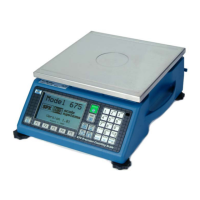What does 'CoDE10 Entry >Max!' mean on GSE Scales?
- MMr. Charles MayoAug 28, 2025
The most likely cause is making an entry for an ID that is longer than the programmed size of that ID.

What does 'CoDE10 Entry >Max!' mean on GSE Scales?
The most likely cause is making an entry for an ID that is longer than the programmed size of that ID.
What does 'CoDE06 Tare> F.S.!' mean on GSE 675?
Most likely the entered tare value was incorrect.
What does 'CoDE81 Macro Stack' mean on GSE Scales?
This error indicates that the maximum number of macros pushed onto the stack has been exceeded. This usually means that macros are being invoked faster than they can be executed.
What does 'CoDE95 SyErr Typ04' mean on my GSE 675 Scales?
The 'CoDE95 SyErr Typ04' error on your GSE Scales indicates an error occurred at startup. Contact GSE.
What does 'tx abort' mean on my GSE 675?
The 'tx abort' message on your GSE Scales occurs if the key is pressed when the tx on hold error message is shown, or if P209 is set for abort and the transmit buffer becomes full.
What does CoDE05 Zero> Max.! mean on GSE Scales and how to fix it?
The error 'CoDE05 Zero> Max.!' on GSE Scales indicates that the zero value is greater than the maximum. Use the key for subtracting off container weights. If a large dead-load is always present, apply this dead-load during the 'No Load?' prompt during calibration to permanently eliminate the offset.
What does CoDE14 Must Keyin mean on GSE Scales?
The 'CoDE14 Must Keyin' error on GSE Scales means that the choice for the current parameter must be keyed in.
How to fix 'Cksum error' on GSE Scales?
A 'Cksum error' indicates a problem with the integrity of its firmware. To fix this, re-flash the indicator.
What does 'CoDE03 Over- Load!' mean on GSE 675 Scales and how to fix it?
The 'CoDE03 Over- Load!' error on your GSE Scales means the input signal is greater than positive full scale. Use the same checks as for an underload situation.
What to do if GSE 675 display 'Code02 Under Load!'?
If the 'Code02 Under Load!' error appears on your GSE Scales, it could be due to excessive loading, in which case you should reduce the load. Otherwise, check the load cell connections. If a 4 wire load cell cable is being used, check that the sense jumpers are in place. Also, verify that the capacity selection P110 is correct; use the information parameters, especially P61103 and P61104, to check the setup and input signal.
Details the structure and purpose of the user manual.
Explains the formatting used for keystrokes and displayed messages.
Defines signal words and symbols for hazards and important notes.
Guidelines for connecting pluggable equipment to accessible sockets.
Specifies isolator requirements for permanently wired connections.
Instructions for safe handling and replacement of batteries to prevent explosion.
Advises against installing the unit near water as it is not a washdown unit.
Details DB9 connector pin assignments for connecting a remote scale.
Instructions for enabling and setting up the Quick Count application.
Details how to store and recall part numbers with average piece weight.
Explains how to access setup menus for the APW Lookup application.
Instructions for using the Quick Count method for parts counting.
Steps for sampling and counting parts using the APW Lookup.
Using the keypad for simple sample and count operations.
Important considerations and tips for performing calibration.
How to enter the calibration mode from the application menus.
Specific steps to access calibration from APW Lookup or Quick Count.
Introduction to the various calibration methods available.
Descriptions and remedies for operational errors like Under Load and Zero Max.